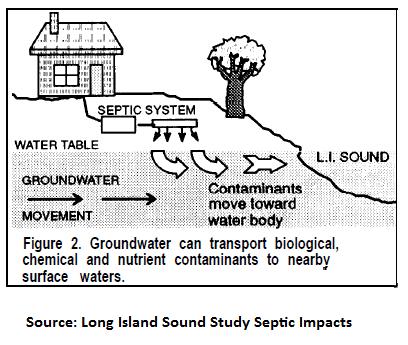Groundwater Contamination
The extent of ground water contamination in an area depends on the hydro-geology of the area and the nature of the contaminant. Contaminants will travel further from the source in highly permeable soils where ground water velocity is greater than in denser soils where ground water velocity is low. In the case of septic system failures, the contaminant source is usually localized and will originate from a single source. When a septic system fails, it will release untreated organic matter into the surrounding soil that could very well possibly reach ground water.
Ground water contamination occurs most commonly when the high ground water line is close enough to the source so that the physical and biological attenuation mechanisms for contaminant removal are not allowed adequate distances to dilute or remove the pollutants. Bacteria and other microorganisms within the subsoil thrive on the introduction of organic matter and use it as an energy source to grow. Biodegradation, the process by which microorganisms consume organic material, is one of the natural attenuation mechanisms for removing contaminants from ground water. The natural physical attenuation mechanisms for contaminant removal are diffusion, advection, dispersion, mechanical filtration, adsorption and radioactive decay.
Diffusion is the process which governs how dissolved molecules and ions move from areas of higher concentration to areas of lower concentration.
Advection is the process which governs how moving ground water carries dissolved solutes as it moves.
Dispersion is the process which acts to dilute solutes and lower their concentrations as the solutes are carried through a porous media, such as the subsoil. The process of Dispersion affects how the concentration of a solute will decrease as the distance from the source of that solute increases.
Contaminants that reach the subsoil can move throughout the stratum in both liquid and gaseous forms. Gases can move in any direction, depending on their density and the relative air pressure gradients, while liquids generally tend to move downward or laterally through the subsoil due to the effects of gravity and groundwater movement.

The best way to avoid a failing septic system from becoming a source of groundwater contamination is by following correct Septic System Maintenance.